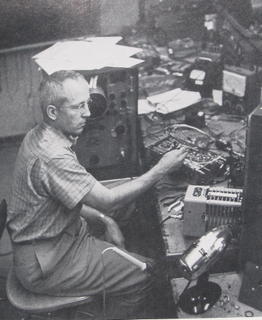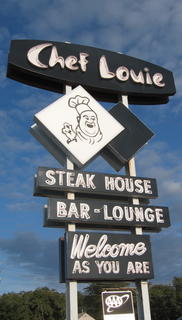 The Columbia River (Photo by Camilla McGuinn)
The Columbia River (Photo by Camilla McGuinn)We left Moses Lake early in the morning on August 28th. Our route on Interstate 84 would take us along the Columbia River. We could have spent days exploring the historic Columbia River Gorge but we wanted to reach the King Estates Vineyard in Eugene, Oregon before nightfall.
I hadn’t heard the news for days, so I turned on the radio. A reporter was interviewing a person in New Orleans who wasn’t going to evacuate even though Hurricane Katrina, a possible category 5 storm, was headed their way.
We are very familiar with hurricanes. Last year our city was hit three times. While listening to the Katrina news, memories of the last hurricane to pass over our home came flooding back.
On Thursday, September 3, 2004, I was sitting in my office when the telephone rang. A quick glance at the caller ID told me something was wrong. The name was Levy, and even though Jacques Levy and his family were dear friends, we seldom called each other. We usually just surprised them when we were in New York City at their SOHO loft.
I picked up the receiver and recognized Claudia’s soft voice. I asked her what was wrong. She told me Jacques was dying.
Roger had met Jacques Levy in 1967. Jacques sent a pretty blonde girl backstage at a BYRDS' concert to ask Roger if he would like to write the music with him for a Broadway play. Jacques figured correctly that the pretty lady would have a better chance of meeting Roger than he would. Jacques was a clinical psychologist turned Broadway producer and he and Roger became not only writing partners, but also close friends.
They were together writing songs when Martin Luther King was shot, the night Robert Kennedy was shot and when the first man walked on the moon. They also wrote songs on and about Bob Dylan’s “The Rolling Thunder Revue”
The news of Jacques imminent leaving this earth hit us like a ton of bricks. We had not known of the lung cancer that Jacques had been battling with for over a year. I told Claudia that we would be in New York City soon. We were scheduled to be in the area for two concerts, but we decided to leave earlier so we could be with the Levy family.
Our original plan had been to leave on Sunday, but Hurricane Jeanne was knocking at our door and was scheduled to hit Orlando on that day. A reporter was flying in on Friday night from London for an interview with Roger. It was that commitment that kept us in Orlando until Saturday at noon. We were praying that we were making the right decisions for everyone involved.
We hit the road and decided to take the inland route because of the weather. The first night we got to Tifton, GA. The next morning we awoke early in order to beat the storm’s northward path. We made it to Virginia. The storm hit the Georgia area we had been in with a lot of flooding.
Monday night we arrive in Weehauken, NJ. As soon as we checked in we called Claudia. They had moved Jacques from the care of Hospice in their home to the hospital. She wasn’t sure if he could see anyone. Later I talked to Maya, their daughter, and asked if it would be possible for Roger to visit Jacques and quietly sing to him the songs that they had written together. Maya said she would ask her mother and the hospital.
Late Tuesday night Maya called and said that everyone thought it was a good idea for Roger to come to the hospital and sing. I told her we would be there Thursday. Roger had a concert in Paramus on Wednesday.
On September 30 we arrived at the intensive care unit of the hospital around 1 p.m. The ICU had eight separate cubicles which were open to the nurses’ station. Jacques was in the first one by the door. He was unconscious, breathing with the help of a respirator. There was no one with him. Roger sat down by his bed, took his 6-string guitar out of the case and started softly singing “Chestnut Mare.”
I stood behind Roger at the entrance to the cubicle. Halfway through the song, Maya walked down the hall. Jacques' beautiful adult daughter greeted me with the longest hug. She went into the room and sat next to Roger. Then Julien, Jacques' sixteen year old son, came slowly walking down the hall with his eyes focused on the floor. He had grown so much since the last time we had seen him.
Julien stood at the entrance with me and we all watched Jacques’ face as Roger sang. We could see faint smiles and when Roger sang, “I Want to Grow Up To Be a Politician,” the corner of Jacques’ mouth turned upward. His sense of humor was intact.
Claudia had been talking to the doctor. It was time to remove the respirator. It was time to let Jacques go.
They took Jacques off the respirator and woke him up, so everyone could say goodbye. He let his family know that he had heard Roger singing. Jacques couldn’t talk but they had figured out ways to communicate.
Roger continued to sing and play until his fingers hurt. He said it was very hard not to cry, but if he cried he couldn’t sing.
Close friends came to the hospital. Roger had a few minutes alone with Jacques. He held Jacques’ left hand and told him he loved him. They made eye contact and even though Jacques couldn’t speak, his eyes lit up with agape love. Roger came away from the hospital with a positive feeling about Jacques’ journey through eternity. It was a peace that surpassed all understanding.
We returned to our hotel in New Jersey on the ferry. We were staying at a hotel on the Hudson river and our room had a view of Manhattan.
Jacques had passed away. The emotions of the day had wearied us, so we had a light supper in the room. After eating we stood looking at the New York City skyline. A full moon shimmered in the sky and then suddenly, a cluster of five silver balloons appeared drifting toward the heavens in the trail of the moonlight. I smiled at Roger and said, “Look at those balloons drifting to the moon. It’s like Jacques is going to heaven.” Roger said that was exactly what he was thinking.
That night, standing quietly looking at the city where he had worked, lived and loved, we said our earthly farewell to Jacques Levy.
The next night, Roger had a concert in Huntington, NY. He told stories about Jacques and sang most of the songs they wrote together. Jacques Levy will always be alive in Roger’s music.






